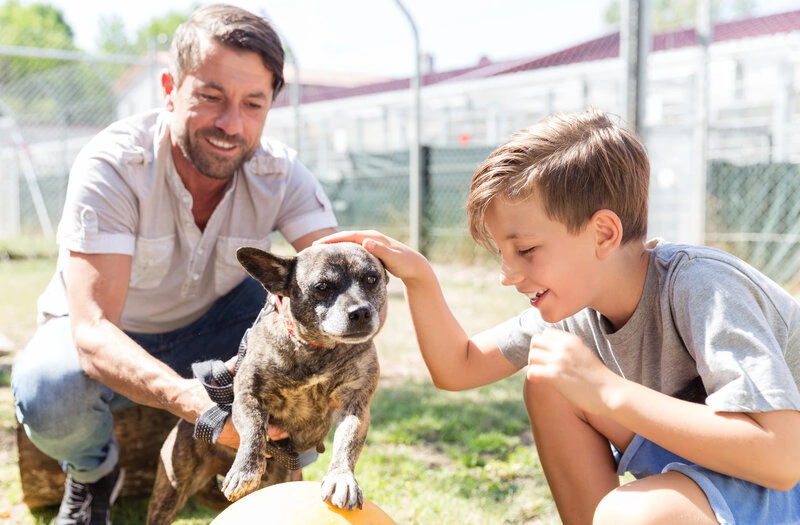
What is your approach to a dog you don’t know? Do you walk up confidently, sticking out your hand “to be sniffed?” Do you connect with the owner first? Do you ignore the dog until the dog expresses calm, confident interest in you? These are some of the most common approaches I see people use when walking about town or at a park or dog park.
The reality is that all dogs and owners are different, and failing to observe specific “dog approach protocols” can lead to unsafe outcomes or a distressed dog, owner, or you!
First and foremost: Never hold your hand out to “be sniffed” unless you are already familiar with the dog and the owner. This is a recipe for bitten or nipped fingers and a triggered dog. That’s precisely the situation we’re trying to avoid.
Instead, there are safer and AKC-approved ways to greet an unfamiliar dog and get to know him/her safely - assuming the dog wants to get to know you at all.
Dogs can’t verbalize their feelings. They rely almost 100% on body language, specific postures, and vocalizations (whines, low growls, obvious growls, and multi-faceted barks).
NOTE: Tail wagging does not necessarily indicate a happy dog. This is one of the most misinterpreted dog gestures. A tail wag means “excitement,” but that excitement could be anything from anxiety, fear, or anger to happy, playful joy. You must understand the more subtle postures of ears, eyes, the position of the head, where the tail is wagging, salivation, raised hackles, etc.
I highly recommend reading the AKC’s post How to Read Dog Body Language, which is an excellent reference to how dogs communicate and what a dog you don’t know is saying to you.
Never rush in with a cheerful voice and a “hello.” This is a friendly greeting between humans but is viewed as a violation of space by dogs. Eagerness or high energy levels can be translated as a sign of aggression for dogs, especially if s/he is in a car (protecting space) or on a leash (guarding his/her owner or feeling restrained).
Stay still and speak calmly, watching the dog for signs of friendliness, calm, and interest in an approach. If the dog signals, “it’s okay to come closer,” move very slowly.
I’d like to say that nobody knows their dog better than the dog’s human companion, but that isn’t always the case. If that were true, Alternative Canine Training wouldn’t be a thriving business. However, owners understand best how their dog tends to behave with strangers, so ask the owner directly before making any motions towards the dog.
Asking, “May I pet your dog” or “may I give your dog a treat,” is always a polite way to begin.
In canine culture, direct eye contact is a sign of dominance and is read as a threat. Always look off to the side a bit when getting to know a new dog. When you approach a dog you don’t know, it’s best to approach low and from the side rather than head-on or from above. Dogs can better assess their level of security that way.
Notice I said “their nose” and not “your hand.” Dogs glean a tremendous amount of information from your smell, but they need to want to smell you.
The idea behind sticking your hand out for a sniff is sound in theory but can be viewed as a threat by a dog. Letting your hands remain loose at your side or even turning sideways (avoiding head-on confrontation) shows the dog that you respect his/her space and passively allow the dog to lead the way.
Most dogs will begin by sniffing your legs or your shoes, with a more enthusiastic sniffing party if you have your own pets at home. They might then smell your hand and nudge it with their nose, which is an invitation to give them a gentle rub.
It’s tempting to pet a dog directly on the head, especially if your dog loves to be petted there. For a dog you don’t know, this top-of-the-head approach can be threatening. Lowering your hand below the dog’s head level is a better way to communicate you are a friend rather than a foe.
Other tips for hand contact with a new dog:
People feel so compassionate towards timid or nervous dogs and are just absolutely sure that their high-pitched tone, love of dogs, and well-meaning kindness will be enough to calm the dog down. It’s not. That type of human behavior intensifies the dog’s nervousness.
The minute you sense a dog is nervous, ignore it altogether. Do not look at it, speak to it, approach it, or interact with it in any way. By acting like the dog isn’t there, you allow the dog to assess the situation. If the dog doesn’t approach you or express interest in you, your job is to respect that.
As the owner and lead trainer at Alternative Canine Training, I witness 100% that the more humans learn to interact with dogs and recognize their signs/signals, the better the human-canine relationship. Do you have a dog that remains nervous or aggressive in public spaces? Contact me to schedule a training session. I will check in and evaluate what is going on for the two of you and provide personalized training and tips to help you embrace the world together with confidence.